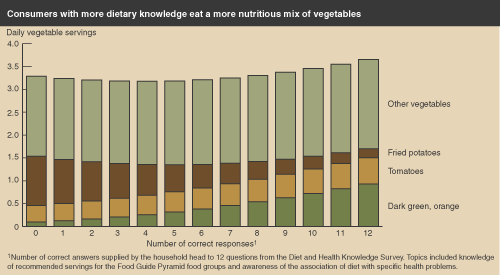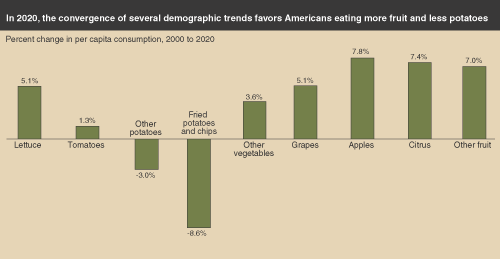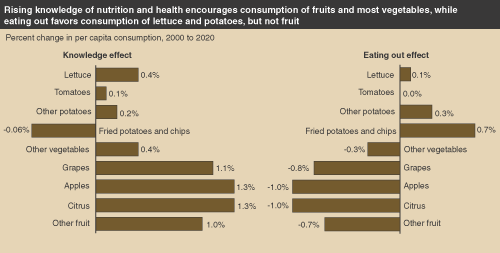Understanding Economic and Behavioral Influences on Fruit and Vegetable Choices
- by Joanne Guthrie, Biing-Hwan Lin, Jane Reed and Hayden Stewart
- 4/1/2005
Encouraging Americans to eat more fruits and vegetables has been a central theme of Federal dietary guidance for more than a decade. A recent Food Marketing Institute survey found that almost 70 percent of American shoppers believe their diets would be healthier if they ate more fruits and vegetables. At the same time, the growth of international trade has enabled supermarkets to keep their aisles stocked with a wide range of fresh produce on a year-round basis. In addition, a bounty of time-saving products, such as bagged, pre-washed spinach and salads or “snack-pack” baby carrots and celery sticks, now provide consumers with convenient preparations and takeout options. Still, despite conditions that would appear to favor higher U.S. consumption of fruits and vegetables, Americans are eating far fewer servings than recommended.
USDA food supply data indicate that Americans consume 1.4 servings of fruit daily, less than half the 4 servings or 2 cups recommended in the 2005 Dietary Guidelines for adults eating 2,000 calories per day. Vegetable consumption is higher, at 3.7 servings per day, but is still below the recommended 5 servings or 2½ cups per day. In addition, even when U.S. consumers heed the advice to eat their vegetables, their choices do not match dietary recommendations. Consumption of dark-green and orange vegetables, two categories emphasized by dietary experts for their nutritional value, is less than half of recommended amounts.
| Groups | 2003 food supply1 | Recommended2 | ||
|---|---|---|---|---|
| Total vegetable | 3.7 | 5.0 | ||
| Dark-green3 | 0.2 | 0.9 (6 servings/week) | ||
| Orange (carrots, sweet potatoes, and others) | 0.2 | 0.6 (4 servings/week) | ||
| Legumes | 0.2 | 0.9 (6 servings/week) | ||
| Potatoes, corn, peas, and other starchy vegetables | 1.3 | 0.9 (6 servings/week) | ||
| Tomatoes and others4 | 1.8 | 1.9 (13 servings per week) | ||
| Total fruit | 1.4 | 4.0 | ||
| Citrus, melon, berries | 0.5 | *No subgroup recommendation | ||
| Other fruit | 0.9 | *No subgroup recommendation | ||
| 1ERS estimates annual amounts of food available for human consumption in the United States. These figures exclude inedible portions and are adjusted for spoilage and waste. 2Based on USDA proposed daily food intake patterns at intake level of 2,000 calories per day. Accessed on November 15, 2004. 3Includes broccoli, spinach, romaine, escarole, and leaf lettuce. 4Other vegetables include iceberg lettuce, onions, cabbage, bell peppers, celery, and cucumbers. |
||||
Fruits and vegetables are vigorously promoted because they offer a wide array of health benefits. They are leading sources of several essential nutrients, such as vitamins A and C and folate. In addition, diets rich in fruits and vegetables are associated with a decreased risk of several chronic diseases, including cardiovascular disease, type 2 diabetes, and some cancers.
Most fruits and vegetables are also naturally low in calories, although their value in weight-control efforts may depend on how these foods are prepared. Using national food consumption data collected by USDA in 1994-96, researchers found eating more fruit to be associated with a lower body mass index (BMI), a measure used by health experts to assess body weight in relationship to height. For example, both obese women and overweight school-age girls ate 1.3 servings of fruit per day, significantly lower than the 1.5 daily servings consumed by healthy weight women and girls. Higher vegetable intake, however, was not consistently related to healthy weight status. The researchers speculate that many people are not eating vegetables in their natural low-fat, low-calorie form, as they would eat fruit. In fact, the most popular vegetable choice of most Americans is fried potatoes.
Marketers and nutritionists alike have puzzled over the reasons for Americans’ fruit and vegetable shortfalls. Are fruits and vegetables too expensive? Are they incompatible with personal and household tastes or the modern trend to more eating out? Do their nutrition benefits matter to knowledgeable consumers? To shed light on the persistent difficulty in increasing U.S. produce consumption, ERS researchers have examined how economic, social, and behavioral factors influence consumers’ fruit and vegetable choices.
Cost Is Not the Only Factor
The cost of fruits and vegetables is a commonly cited reason why consumers don’t eat more of these healthy foods. This is somewhat surprising, since rising incomes and low food prices mean that Americans now spend less of their income on food than ever before—10.1 percent of disposable personal income in 2002 versus 20.5 percent in 1950. ERS researchers using 1999 at-home food purchase data found numerous options among both fresh and processed fruits and vegetables whereby consumers could meet Food Guide Pyramid recommendations for less than $1 per day.
Nevertheless, income-constrained consumers may not make purchasing fruits and vegetables a high priority. Other ERS researchers examining the at-home fruit and vegetable purchases by households over a 2-week period in 2000 found that low-income households spent $3.59 per person per week on fruits and vegetables. Nineteen percent of poor households purchased no fruits and vegetables at all. By contrast, higher income households spent $5.02 per person per week on produce, with only about 9 percent of households buying no fruits and vegetables. Moreover, small increases in income were likely to induce greater fruit and vegetable spending among higher income households, but had no impact on spending by low-income households. Among all income levels, education had a much greater impact on household produce purchases than did income. Controlling for income, college-educated households had the highest level of per capita fruit and vegetable expenditures ($5.99 per person per week versus $4.25 for households headed by a high-school-only graduate).
A person’s knowledge of nutrition also influences his or her choice of what foods go on the plate. Using data from the 1994-96 Continuing Survey of Food Intakes by Individuals and its companion Diet and Health Knowledge Survey, ERS researchers found that consumers with more nutrition knowledge not only ate more vegetables, they also chose a more healthful mix of vegetables than other consumers. These findings provide evidence of the value of nutrition knowledge, but other personal and lifestyle characteristics help determine food choice, and their influences may enhance or negate the effectiveness of information.
Household Composition, Cultural Background Also Play a Role
Federal dietary guidance emphasizes that consumers should choose a varied mix of vegetables to get a wide range of essential nutrients. In particular, USDA has urged Americans to increase their consumption of nutrient-rich deep-green and orange vegetables, such as broccoli, spinach, carrots, and winter squash. Examining 1999 at-home food purchase data, ERS researchers hypothesized that the number of different types of vegetables purchased over a year would vary by household composition, with larger households purchasing a more varied mix. Larger households are thought to cook more meals from scratch, with vegetables commonly used in preparing such meals. Up to a point, this turned out to be true. Households with four members bought 16 of 24 different popular vegetable types, compared with just 10 types for single-person households. But when household size reached five or more members, variety in vegetable purchases began to decline, with households of six members buying 14 types of vegetables. A possible explanation may be that in larger households, it can be difficult to prepare meals that please all members. Meal planners in such households may tend to compromise by repeatedly choosing the subset of vegetables that everyone likes.
The kinds of individuals in a household also influence food purchases. More educated households bought a slightly more varied mix of vegetables. By contrast, the presence of children exerted a negative influence on the variety of purchases—reducing the number of different vegetables bought by one. This effect demonstrates the veto power children can have over vegetables they dislike.
In addition, a household’s ethnic background plays a role. Traditional Asian and Hispanic foods incorporate a wider variety of vegetables than some other cuisines. All else equal, Asian households tend to buy one to two more types of vegetables, and Hispanic households about one more, than White, non-Hispanic households.
More Eating Out = Less Fruit and Vegetables
The most important food-related lifestyle change of the past two decades is probably the increase in consumption of food prepared away from home, whether eaten in restaurants, as takeout, or as home-delivered meals. Data from USDA’s Continuing Survey of Food Intakes by Individuals, collected in 1994-96 and 1998, indicate that Americans consume about a third of calories from food prepared away from home, up from less than a fifth in 1977-78.
But when Americans order their restaurant or takeout meals, fruits and most vegetables seldom make the list. Away-from-home food accounts for less than half a serving of fruit, and one and a quarter servings of vegetables. Moreover, vegetable choices while dining out are less likely to match USDA guidance—fried potatoes make up approximately 35 percent of vegetables eaten away from home, compared with 10 percent of at-home vegetable consumption.
Factors Predicting Change in Fruit and Vegetable Consumption
Looking ahead to 2020, demographic and socioeconomic factors are expected to influence fruit and vegetable consumption. The aging of the U.S. population will likely favor fruit consumption and consumption of most vegetables except fried potatoes. Rising incomes and education levels should produce similar trends. The increase in the Hispanic population is expected to favor consumption of tomatoes, which feature prominently in Hispanic dishes. These trends are projected to increase per capita fruit consumption between 5 and 8 percent, and increase per capita consumption of most vegetables. Potatoes are the major exception, with per capita intake of fries and chips projected to drop by almost 9 percent; other forms of potatoes may drop by 3 percent.
The influence of income on projected demand for fruits and vegetables is complex. People with higher incomes generally have more years of schooling and greater nutrition knowledge, but they also tend to eat out more frequently. These factors have powerful but contradictory effects. Equipped with higher education and greater nutrition knowledge, consumers choose more fruits and vegetables, except fried potatoes and chips. But, when eating out, choices often include less fruit, and more potatoes and lettuce.
Opportunities and Challenges for Promoting Produce
These findings should give nutritionists, marketers, and others seeking to promote fruit and vegetable consumption a sense of both opportunities and challenges. Overall, the findings indicate that information does matter—better educated consumers with more nutrition knowledge consume more fruits and vegetables and make more nutritious choices within the category. This should be encouraging to campaigns that focus on increasing consumer awareness of the health benefits of these foods.
Information is not, however, the only factor guiding consumer choice, and promotional advice that provides flexible strategies for accommodating a range of preferences and lifestyles may be more effective than nutrition information alone. Householders with large families or picky children may benefit from practical advice on how to accommodate the varied preferences of household members. Promotional efforts also need to consider cultural preferences. For fruit and vegetable promotions to be effective in a diverse society, it is important to examine how variety can be promoted within the context of specific cultures and cuisines.
The trend to eat more and more meals outside the home is probably the biggest challenge to those seeking to promote fruit and vegetable consumption, given the very small amounts of fruit and most vegetables consumed away from home. While increasing nutrition knowledge is expected to raise fruit and vegetable consumption, increased eating away from home could negate these gains. Recently, restaurants and fast food establishments have expanded their menus to include more healthful options, such as salads and fresh-cut fruit.
As these ERS research findings demonstrate, many behavioral and economic factors influence the consumer's decision to eat fruits and vegetables. Understanding these factors will help the food industry develop and market fruit and vegetable products that offer consumers convenience, flexibility, and options when eating out. But in the end, consumer preference drives the marketplace. If educational and promotional strategies succeed in getting consumers to reach for fruits and vegetables more often
This article is drawn from:
- Guthrie, J. (2004). Understanding Fruit and Vegetable Choices: Economic and Behavioral Influences. U.S. Department of Agriculture, Economic Research Service. AIB-792-1.
- Reed, J., Frazão, E. & Itskowitz , R. (2004). How Much Do Americans Pay for Fruits and Vegetables?. U.S. Department of Agriculture, Economic Research Service. AIB-790.
- Blisard, N., Stewart, H. & Jolliffe, D. (2004). Low-Income Households' Expenditures on Fruits and Vegetables. U.S. Department of Agriculture, Economic Research Service. AIB-792-5.
- Lin, B., Variyam, J., Allshouse, J.E. & Cromartie, J. (2003). Food and Agricultural Commodity Consumption in the United States: Looking Ahead to 2020. U.S. Department of Agriculture, Economic Research Service. AER-820.
- "Higher Fruit Consumption Linked With Lower Body Mass Index," FoodReview 25(3). (2002). USDA/ERS.
We’d welcome your feedback!
Would you be willing to answer a few quick questions about your experience?




